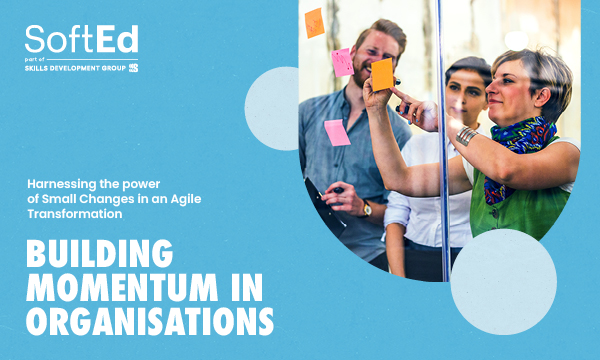Harnessing the power of Small Changes in an Agile Transformation: Building Momentum in Organisations

Today’s organisations are constantly seeking ways to adapt, thrive and become more effective in the way that they work. Many organisations adopt an agile way of working to help foster better innovation, improved efficiency, and deliver value to customers quicker. However, embarking on an agile journey can be daunting, requiring significant investment in culture, processes, and mindset. While it's tempting to focus on large-scale initiatives, it is often that small changes can have a more profound impact on the success of an organisation’s agile journey. With that in mind, let’s explore six focus areas that can potentially help an organisation become more agile.
Cultural Shift
It is said that culture eats strategy[1]. This is often thought of as strategy, whilst critical, may not achieve the desired benefits unless or until people buy into the strategy or changes in a way that ‘tolerates’ the change[2]. Small changes in behaviour and mindset can gradually shift the organisational culture towards increasing agility. Encouraging open, honest, effective two-way communication, embracing failure as a learning opportunity, and promoting collaboration across teams are small-ish but powerful steps the help an organisation embrace a more agile approach to working. Leaders play a crucial role in modelling these behaviours and reinforcing them.
Iterative Improvement
Agile change is not a one-time event but a continuous journey of improvement. By breaking down large initiatives into smaller, manageable activities, teams can iterate more frequently and adapt to changing requirements and market conditions. Embracing an "inspect, adapt and improve" mentality allows organisations to make incremental improvements over time sooner. This can lead to potentially higher performance, better outcomes, and increased agility.
Empowering Teams
Changes in team dynamics can empower individuals to take ownership and accountability for their work. Encouraging self-organising, self-managing teams, giving them aligned autonomy in order to make effective decisions, and providing the necessary support and resources can unleash their creativity and drive innovation. As teams become more empowered, they potentially become more resilient to change and better equipped to respond to customer needs.
"Change will not come if we wait for some other person or some other time. We are the ones we've been waiting for. We are the change that we seek.” — Barack Obama
Continuous Learning
An agile journey requires a shift from a fixed mindset to a growth mindset[3], where learning and improving is valued and encouraged at all levels of the organisation. Implementing small changes such as regular knowledge sharing sessions, cross-functional training, regular learning reflection events (retrospectives) and creating a culture of experimentation can foster a culture of continuous learning. By investing in the development of their people, organisations can build a more adaptive and resilient workforce.
Feedback Loops
Small changes in the way feedback is collected and acted upon can significantly improve team performance and product quality. Implementing regular retrospectives, gathering feedback from customers early and often, and using appropriate metrics to track progress can help teams identify areas for improvement and make course corrections as needed. By understanding what feedback loops are effectively working, what bottlenecks exist and amplifying them and adding double loop feedback[4] approaches into processes, work and people, organisations can quickly adapt to changing market dynamics and customer preferences.
Leadership Support
Leadership plays a critical role in driving and sustaining an agile journey. Changes such as aligning with agile principles, removing organisational barriers, understanding bottlenecks, unlearning behaviours to learn and providing visible support and sponsorship can signal to the rest of the organisation that agile is a strategic priority. By demonstrating their commitment to agile values and principles, leaders can create an environment where teams feel empowered to embrace change and take ownership of their work.
In conclusion, while an agile journey may seem like a daunting task, small changes can pave the way for success. By focusing on cultural shift, iterative improvement, team empowerment, continuous learning, feedback loops, and leadership support, organisations can build momentum towards becoming more agile and adaptive. Ultimately, it's the collective effort of individuals and teams embracing these changes that will drive lasting transformation and enable organisations to thrive in today's rapidly changing world.
_________________________________________________________
This article was written by Brian Osman, a SoftEd trainer and coach who tries to bring the human side of agile to life by empowering students to see the broader perspective and applications of agile.
Cited Sources:
[1] https://www.forbes.com/sites/forbescoachescouncil/2018/11/20/why-does-culture-eat-strategy-for-breakfast/?sh=644c02c21e09
[2] https://en.wikipedia.org/wiki/Culture
[3] https://online.hbs.edu/blog/post/growth-mindset-vs-fixed-mindset
[4] https://en.wikipedia.org/wiki/Double-loop_learning#:~:text=Double%2Dloop%20learning%20entails%20the,hence%20%22double%2Dloop%22.
Thank you!
Your details have been submitted and we will be in touch.